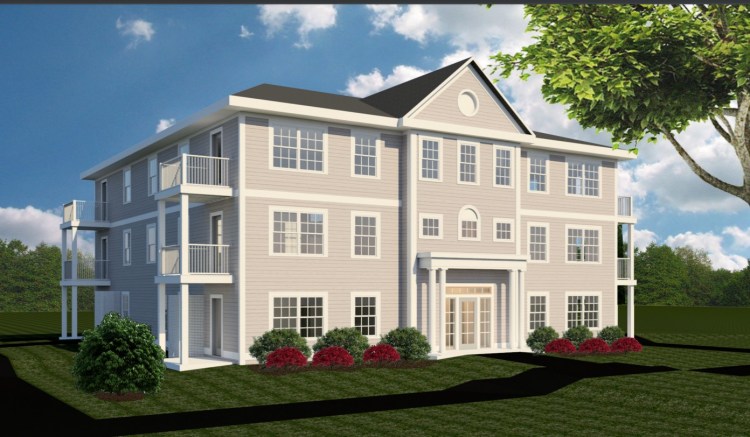Dozens of new apartments are being proposed in Portland’s East Deering neighborhood, one quarter of which will be earmarked for middle-income families.
Developer Kevin O’Rourke has proposed building four 12-unit apartment buildings at 0 Dalton Street. Half of the units at Winchester Woods would be one-bedroom units and the rest would be two-bedroom units, he said. Each unit will have its own outdoor patio or porch.
O’Rourke, who is currently building a 16-unit condominium building on Hammond Street in East Bayside, said he plans on holding a neighborhood meeting in the coming weeks. He said leasing of units will likely begin about six months after securing the necessary approvals, permits and breaking ground.
“I’m excited to do this project,” he said. “It’s fulfilling a need Portland has for housing. And it’s basically making use of a piece of land that has sat underutilized for 150 years.”
The proposal is one of the first to be subject to the new affordability requirements established in the Green New Deal for Portland, which was enacted by voters in November.
The ordinance increased the percentage of units in certain developments that need to remain affordable to middle-income families from 10 percent to 25 percent. It also reduced the household incomes that determine affordability from up to 100 percent of the area median income to 80 percent. The AMI is currently $70,630 for one person and $100,900 for a family of four.
Deputy Planning Director Kevin Kraft said it was too early to comment on the specifics of the proposal, which has not yet been reviewed by the Planning Board.
“It is one of the few projects we’ve seen proposed under the new inclusionary zoning rules but it’s not the first,” Kraft said. “We’re relatively early in the review process for Dalton Street but this project is a welcomed and needed addition to the City’s overall housing supply. It’s exciting to see them move forward.”
Access to the apartments will be off Sherwood Street, and an existing trail linking Sherwood Street to Presumpscot Elementary School is expected to be upgraded, according to planning documents.
City Councilor Andrew Zarro, who represents the neighborhood, said he hasn’t heard from constituents about the project, since the review process is in the early stages.
Cheryl Leeman, a former longtime district councilor and president of the East Deering Neighborhood Association, said she was not aware of the project, which consists of four four-story buildings and 63 off-street parking spaces, but she expected some concerns from residents in the neighborhood of predominantly single-family houses.
“I can’t believe there would not be serious concerns about the mass & scale of (48 units) along with further concerns about meeting the City’s Comprehensive Plan regarding whether or not it is a ‘contextually appropriate density’ consistent with the current ‘established pattern of the development’ in that neighborhood which is mostly single family homes on a short dead end street,” Leeman said in an email.
Kraft said the first project to come forward under the stricter affordability guidelines in the Green New Deal for Portland was a senior housing project proposed on Winter Street by the nonprofit Community Housing of Maine. But that project, he said, is seeking subsidies to remain affordable, including an affordable housing tax break from the city and additional funding from either the HOME program or the city’s housing trust fund.
O’Rourke said his estimated $7.5 million project will not seek any city subsidies. Instead, he’s able to make it work because he got a relatively good deal on the land since there was a lingering legal issue that he was able to clear up. That legal issue, he said, involved an old paper street that was listed on a previous subdivision dating back to 1846.
But O’Rourke said both the increased affordability guidelines, coupled with the new rent control ordinance, also enacted by voters last fall, will likely increase the rents on the market-rate apartments.
Monthly rents for the inclusionary zoning units, he said, are currently estimated to be $1,373 for a 700-square-foot, one-bedroom unit and $1,570 for a 925-square-foot, two-bedroom unit.
He said he is still conducting research to determine the market-rate rents, but he suggested he’d likely aim high, since future rent increases will be limited to inflation and property tax increases. Any increases beyond that would require approval from the new Rent Board, but the rents can be lowered at any time, he said.
“It makes establishing those starting rents that much more critical because you’re basically frozen at that margin,” he said. “If we go out with rents and we’re not filling units, it’s always easier to drop them, as opposed to raise them. So the likelihood is that we may go out on the slightly more aggressive side.”
Moving forward, he’s worried that limiting rent increases to inflation may not reflect the real cost increases of maintaining the buildings and property, such as plowing, lawn mowing and the like, since the prices of those services respond to demand and the availability of labor.
“I don’t know if any of that stuff will be reflected in the rate of inflation,” he said. “I can see my costs increasing maybe not proportionally with the rate of inflation.”
He added, “We’re operating … a little bit in the dark.”
Send questions/comments to the editors.




Success. Please wait for the page to reload. If the page does not reload within 5 seconds, please refresh the page.
Enter your email and password to access comments.
Hi, to comment on stories you must . This profile is in addition to your subscription and website login.
Already have a commenting profile? .
Invalid username/password.
Please check your email to confirm and complete your registration.
Only subscribers are eligible to post comments. Please subscribe or login first for digital access. Here’s why.
Use the form below to reset your password. When you've submitted your account email, we will send an email with a reset code.